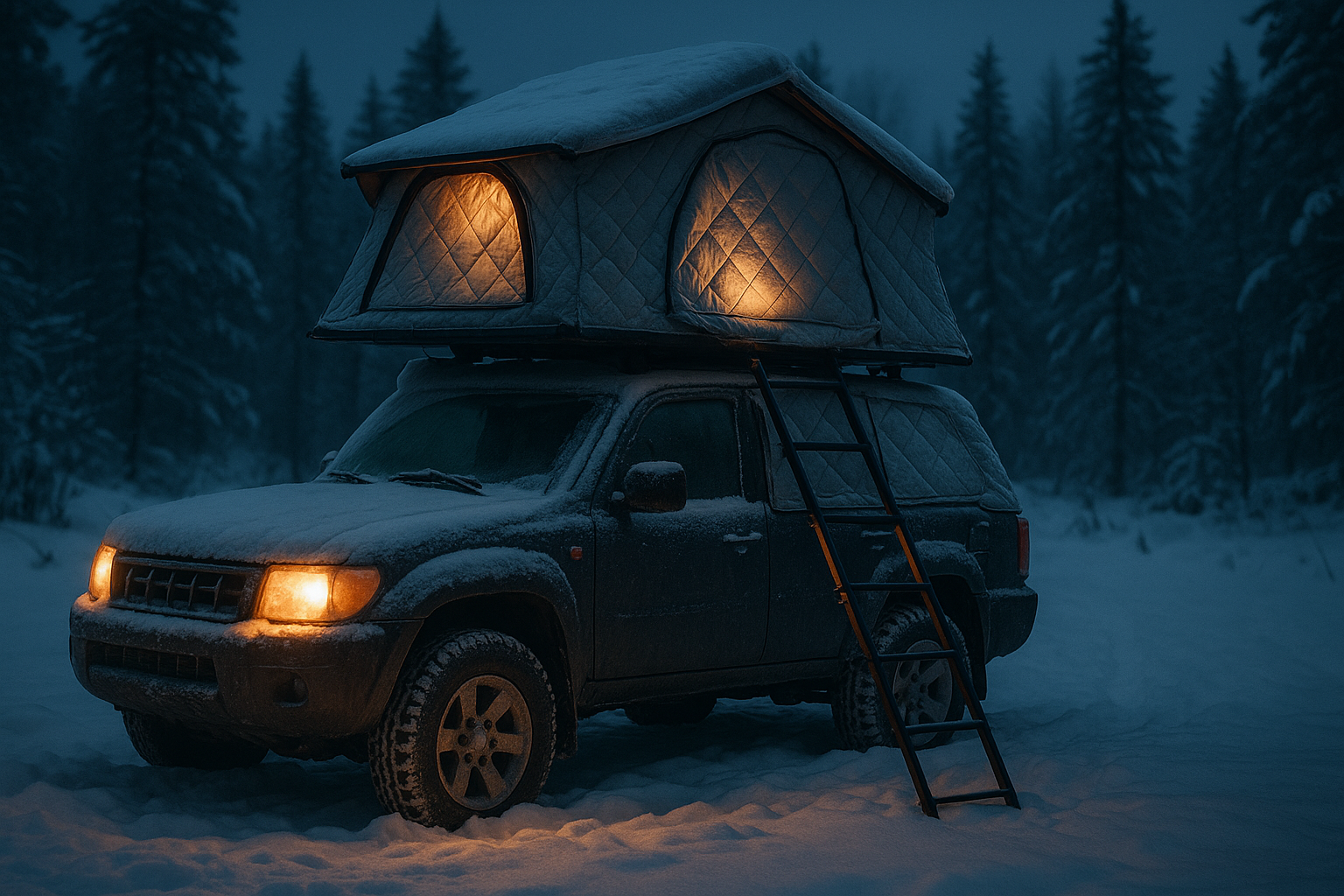The sun’s gone, the wind’s picked up, and the temperature’s dropping fast. You’re in your rooftop tent, shivering, realizing that what felt warm in the afternoon is now a bitterly cold trap. When a sudden temperature drop catches you off-guard, you don’t have time for complicated gear or trips back to basecamp. But with a survivalist mindset and a bit of ingenuity, you can turn your rooftop tent into a cozy haven—using what you already have.
1️⃣ Layered Reflective Insulation: Field-Ready Heat Traps
Create a barrier that reflects your body heat back:
- Use emergency blankets (Mylar), foil-lined snack wrappers, or reflective car sunshades.
- Line the ceiling and walls of your tent with these, securing them with tape, clips, or cord.
- Focus on covering areas directly above your sleeping space.
🛠 Why it works: Reflective materials bounce body heat back, creating a radiant heat effect without bulky insulation.
2️⃣ Floor Insulation Hack: Dead Air Buffer
The rooftop tent floor gets cold fast. Here’s how to stop that:
- Lay down foam mats, spare clothing, or even flattened cardboard boxes.
- Layer with a folded tarp or groundsheet for added wind protection.
- If you have extra sleeping bags or blankets, spread them underneath your main sleep setup.
🛠 Why it works: Multiple layers trap dead air, reducing heat loss through conduction.
3️⃣ Create a Thermal Cocoon with What You Have
If the temperature’s plummeting:
- Use a spare groundsheet, poncho, or tarp to drape over your sleeping bag, inside the tent.
- Layer blankets or spare clothing around your body.
- Create a “nest” effect with soft items around your shoulders, knees, and feet to reduce convective heat loss.
🛠 Why it works: Trapping warm air around your body helps maintain core temperature through the night.
4️⃣ DIY Wind Blockers: Patch Gaps and Vents
Cold air sneaks in through cracks and vents:
- Plug gaps with stuff sacks, spare clothes, or rolled towels.
- Use plastic bags or tarps to cover large mesh windows or vents temporarily.
- If the wind is strong, anchor makeshift barriers outside with rocks or branches.
🛠 Why it works: Reducing air infiltration preserves the warmth you’ve built up inside.
5️⃣ Warmth from Below: Insulated Sleeping Setup
Your sleeping gear matters, even in a rooftop tent:
- Line your sleeping bag with a space blanket or thermal liner.
- Sleep on top of extra layers, like spare clothes or even a backpack, to insulate from the cold base.
- If no extra layers are available, fill trash bags with leaves or pine needles and use them as padding.
🛠 Why it works: Insulating from below prevents conductive heat loss, a common cause of overnight chill.
6️⃣ Harness Body Heat: Share the Warmth
If you’re camping with others:
- Sleep close together, maximizing shared body heat.
- Create a shared cover, like a large blanket or tarp, over both sleeping bags.
- If solo, use a backpack or bag filled with clothes as a heat source near your torso or feet.
🛠 Why it works: Shared warmth exponentially reduces heat loss, a classic survival tactic.
7️⃣ Stash Heat Sources: Improvise a Radiator
Use any available heat sources safely:
- Fill a metal water bottle or rock with hot water from a camp stove or fire and wrap it in a sock or cloth.
- Place it inside your sleeping bag or at your feet.
- Replace it with a new one if it cools off during the night.
🛠 Why it works: Radiant heat from a thermal mass provides steady warmth for hours.
8️⃣ Tighten and Seal the Tent Structure
A taut tent fabric reduces heat loss:
- Re-tighten guy lines and corners to minimize flapping and drafts.
- Add extra guy lines or lashings if the fabric feels loose.
- Check for tears or holes, and patch them with duct tape or fabric patches.
🛠 Why it works: A snug setup reduces cold air infiltration and heat escape.
9️⃣ Create an Insulated Roof Canopy
For advanced cold weather:
- Rig a tarp or spare groundsheet over the tent roof, leaving a gap between the layers.
- Secure with cord, rocks, or stakes to create an air buffer.
- Use light-colored materials to reflect heat inside during daytime sun.
🛠 Why it works: The air gap acts as an insulative barrier, reducing heat loss through the tent roof.
10️⃣ Boost Warmth with Simple Tricks
- Wear a hat and socks to retain body heat.
- Eat a warm meal before bed to fuel metabolism.
- Do light exercise (like jumping jacks) before sleeping to raise core temperature.
- Keep water bottles inside your tent to prevent freezing and allow for warm refills.
🛠 Why it works: These small, deliberate actions enhance insulation and prepare your body for cold sleep.
Real-World Camper Tips:
🔹 “I used an emergency blanket as a liner under my sleeping bag—it trapped so much warmth I had to vent the bag at dawn.”
🔹 “Plastic bags filled with dry leaves under my mattress turned a freezing night into a tolerable one.”
🔹 “I always sleep with a hat and scarf in my rooftop tent—game changer.”
Conclusion:
Sudden temperature drops don’t have to ruin your camping experience. By layering reflective materials, insulating with what you have, and managing airflow, you can turn your rooftop tent into a warm sanctuary. Whether it’s plugging gaps with spare clothes or using a hot water bottle as a heat source, these field-tested hacks will keep you warm when the cold catches you off-guard.
🔥 Don’t just survive the freeze—outsmart it.

